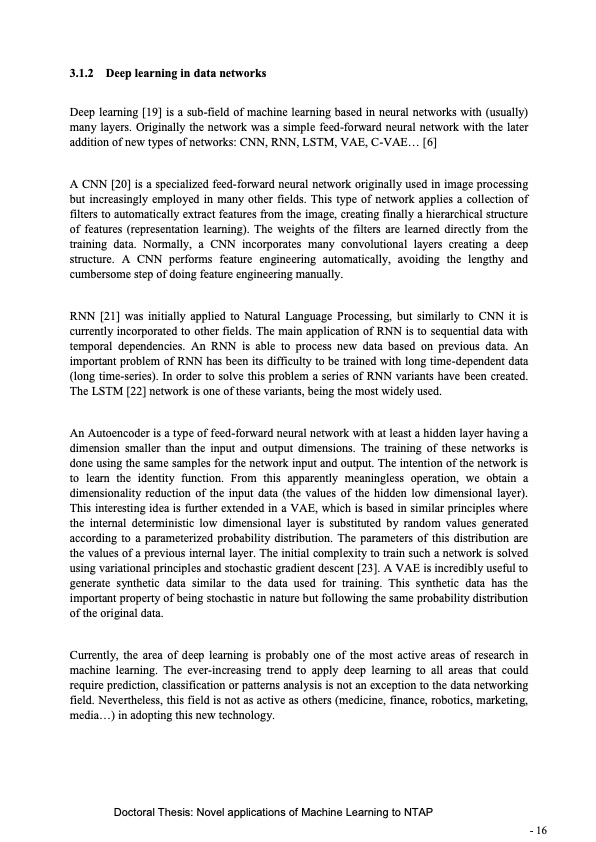
PDF Publication Title:
Text from PDF Page: 018
3.1.2 Deep learning in data networks Deep learning [19] is a sub-field of machine learning based in neural networks with (usually) many layers. Originally the network was a simple feed-forward neural network with the later addition of new types of networks: CNN, RNN, LSTM, VAE, C-VAE... [6] A CNN [20] is a specialized feed-forward neural network originally used in image processing but increasingly employed in many other fields. This type of network applies a collection of filters to automatically extract features from the image, creating finally a hierarchical structure of features (representation learning). The weights of the filters are learned directly from the training data. Normally, a CNN incorporates many convolutional layers creating a deep structure. A CNN performs feature engineering automatically, avoiding the lengthy and cumbersome step of doing feature engineering manually. RNN [21] was initially applied to Natural Language Processing, but similarly to CNN it is currently incorporated to other fields. The main application of RNN is to sequential data with temporal dependencies. An RNN is able to process new data based on previous data. An important problem of RNN has been its difficulty to be trained with long time-dependent data (long time-series). In order to solve this problem a series of RNN variants have been created. The LSTM [22] network is one of these variants, being the most widely used. An Autoencoder is a type of feed-forward neural network with at least a hidden layer having a dimension smaller than the input and output dimensions. The training of these networks is done using the same samples for the network input and output. The intention of the network is to learn the identity function. From this apparently meaningless operation, we obtain a dimensionality reduction of the input data (the values of the hidden low dimensional layer). This interesting idea is further extended in a VAE, which is based in similar principles where the internal deterministic low dimensional layer is substituted by random values generated according to a parameterized probability distribution. The parameters of this distribution are the values of a previous internal layer. The initial complexity to train such a network is solved using variational principles and stochastic gradient descent [23]. A VAE is incredibly useful to generate synthetic data similar to the data used for training. This synthetic data has the important property of being stochastic in nature but following the same probability distribution of the original data. Currently, the area of deep learning is probably one of the most active areas of research in machine learning. The ever-increasing trend to apply deep learning to all areas that could require prediction, classification or patterns analysis is not an exception to the data networking field. Nevertheless, this field is not as active as others (medicine, finance, robotics, marketing, media...) in adopting this new technology. Doctoral Thesis: Novel applications of Machine Learning to NTAP - 16PDF Image | Novel applications of Machine Learning to Network Traffic Analysis

PDF Search Title:
Novel applications of Machine Learning to Network Traffic AnalysisOriginal File Name Searched:
456453_1175348.pdfDIY PDF Search: Google It | Yahoo | Bing
Cruise Ship Reviews | Luxury Resort | Jet | Yacht | and Travel Tech More Info
Cruising Review Topics and Articles More Info
Software based on Filemaker for the travel industry More Info
The Burgenstock Resort: Reviews on CruisingReview website... More Info
Resort Reviews: World Class resorts... More Info
The Riffelalp Resort: Reviews on CruisingReview website... More Info
| CONTACT TEL: 608-238-6001 Email: greg@cruisingreview.com | RSS | AMP |